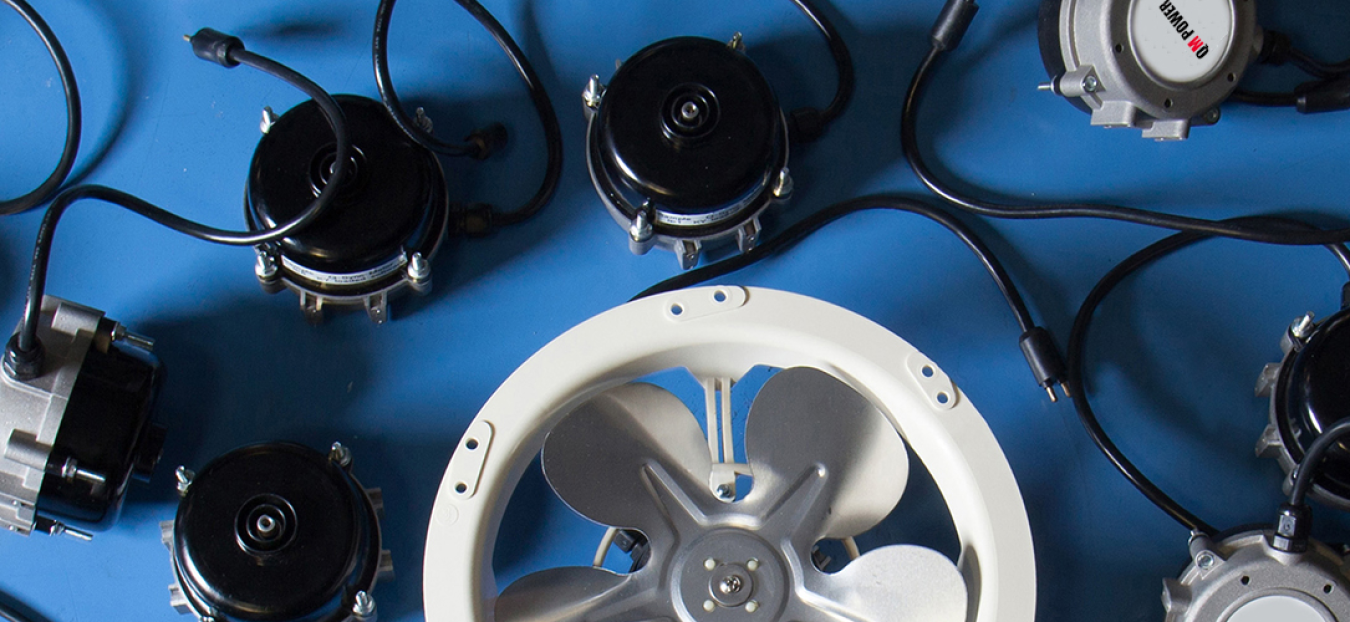Thanks to a DOE Building Technologies Office funding award, QM Power is demonstrating its technology, called the Q-Sync fan motor, in supermarkets.
June 7, 2016
QM Power discusses the company's new refrigeration motor with a supermarket. (Source: QM Power)

Source: QM Power
Technology History
- Commercialized under a DOE SBIR grant
- Technology evaluation through ORNL partnership
- Demonstration projects with grocery stores across the nation
Project Partner
- Oak Ridge National Laboratory (ORNL)
Applications
- New and existing commercial refrigeration equipment
Benefits
- 50% more efficient than ECMs (next-best technology)
- Twice as long warranty
DOE Contact Information
Funding
- $1,004,653 (DOE)
- $1,004,653 (Cost-Share)
Third-Party Verified Demonstrations Prove Energy Savings of up to 80% over Conventional Motors
Every year, an average-sized grocery store spends more than $200,000 on energy and releases 1,900 tons of carbon emissions. Refrigeration accounts for close to half of a grocery store’s total electricity usage, making investing in more efficient refrigeration a great solution to immediately start cutting utility bills.
But over the past half century, there has been little innovation in the motors that drive commercial refrigerators’ energy usage—until now. Through a DOE Small Business Innovation Research (SBIR) grant, Kansas City, Missouri-based QM Power recently commercialized a high-efficiency motor for commercial refrigerators that has the potential to revolutionize the market. Now, thanks to a DOE Building Technologies Office (BTO) funding award, QM Power is demonstrating its technology, called the Q-Sync fan motor, in supermarkets across the country, with DOE and utilities verifying the savings. Customers are now using these successful demonstrations to accept and commercialize the Q-Sync fan in their refrigeration units.
A Brief History
Fan motors are critical to the open-cased refrigerators used in most grocery stores. They help circulate cool air and evaporate condensation—keeping food cool and safe. The two most common types of motors on the market today are based on decades-old technology: shaded-pole motors (developed in the 1880s) and electronically commutated motors (ECMs) (developed in the 1960s). More than 65% of all commercial refrigeration fans deployed are shaded-pole—which are only 20% energy efficient. ECMs, making up the remaining 35% of the market, are about 60% efficient but still lose significant power continually converting between AC and DC power.
An Innovative Motor Poised to Change the Market
The Q-Sync 6-12 watt motor is a synchronous motor, meaning the rotation of the motor’s shaft is synchronized with the frequency of the supplied current. Previously, this technology was too expensive for commercial refrigeration applications, but QM Power’s solution enabled lower costs in the controller, which eliminates the need for power conversion after the motor starts.
The advanced electronics quickly get the motor to the targeted speed, and then efficiently shift the motor to AC power supplied directly from the grid. With this innovative technique, Q-Sync cuts energy use by 30% compared to ECMs, and by up to 80% compared to shaded-pole motors. If fully adopted, QM Power predicts this innovative, highly efficient, and cost-effective motor technology has the potential to achieve more than 0.6 quads and $1 billion in energy savings.
The Key to Market Acceptance: Third-Party Validation
Despite the technological improvements, original equipment manufacturers (OEMs) and grocery stores were hesitant to try a new technology without third-party validation from an already trusted larger firm or government laboratory. In fact, this is a common issue many small businesses face when trying to scale up a new technology. It’s also where BTO was able to help—by strengthening this small company’s big idea through real-world demonstrations.
Through a funding award from BTO’s Commercial Buildings Integration program, QM Power partnered with Oak Ridge National Laboratory (ORNL) to install and demonstrate approximately 10,000 high-efficiency Q-Sync fan motors in commercial refrigeration fan applications in more than 50 grocery stores across the United States, and then evaluate the energy savings.
At a Price Chopper demonstration in the Kansas City-metro area, replacing some of the shaded-pole motors with Q-Sync motors resulted in an energy reduction of 78.4% in the refrigeration cases with the Q-Sync motors. Another demonstration took place at Safeway-Albertsons, where Q-Sync used 71% less energy than the shaded-pole motor and 38% less energy than the ECM it replaced.
These demonstrations are validating this technology’s effectiveness to the public. ORNL published the results of the first DOE demonstration in a report, giving QM Power the backing it needed to secure additional adoption sites. Shortly after the ORNL report was published, another field trial in a San Diego supermarket led a consortium of utilities in California to publish a report recommending that utilities incentivize customers to replace all commercial refrigeration motors (including ECMs) with Q-Sync motors.
The Road Ahead
This report, and the demonstrations, have greatly increased QM Power’s visibility throughout the industry, significantly escalating market adoption. As a result, QM Power recently moved to a larger manufacturing plant in Kansas City, Missouri, and has plans to hire 12 more employees by the end of the year. The company is continuing to work directly with market leading OEMs, distributors, retrofit contractors, grocery stores, utilities, and other organizations to expand market adoption of its motor.
The core technology has big potential in other applications too, such as evaporator and condenser fans in domestic refrigerators and freezers, walk-in coolers and freezers, and commercial and residential HVAC systems—which collectively number in the hundreds of millions and whose fans use 30 times as much energy as the Q-Sync fan motors. As ORNL reported, a broader upgrade to Q-Sync fan motors in these applications could reduce source energy consumption by as much as one quad, or 1% of the country’s entire annual energy usage.

